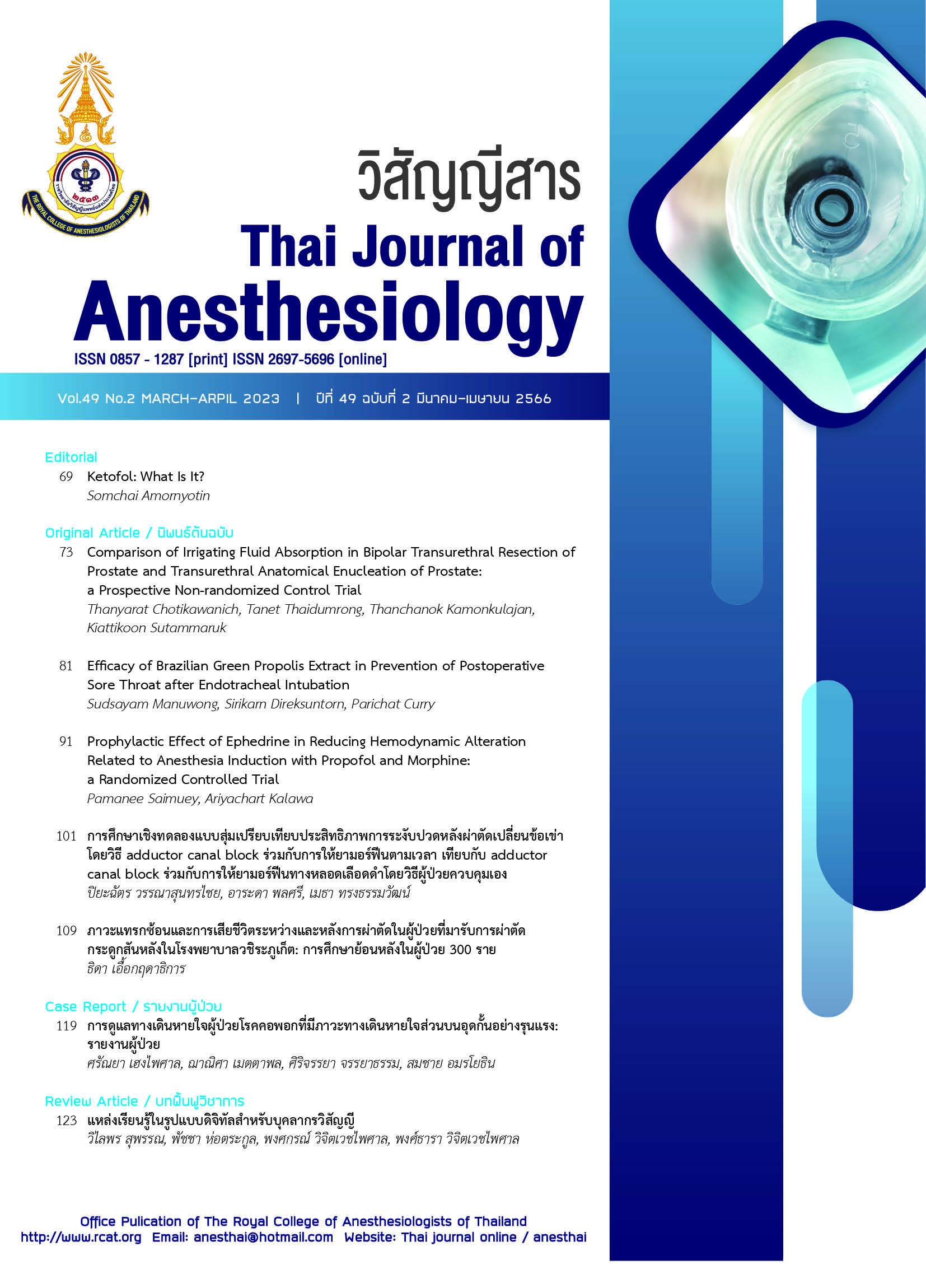Prophylactic Effect of Ephedrine in Reducing Hemodynamic Alterations Related to Anesthesia Induction with Propofol and Morphine: a Randomized Controlled Trial
Main Article Content
Abstract
Background and aim: Anesthesia induction by using propofol and morphine is associated with hypotension and bradycardia. In this randomized controlled trial, we compared the prophylactic effects of 0.1 and 0.2 mg/kg of ephedrine in reducing hemodynamic alterations related to anesthesia induction. Methods: This is a clinical randomized controlled trial with 111 patients receiving elective surgery under general anesthesia. Patients were divided into three groups before inducing anesthesia with 2.5 mg/kg of propofol and 0.1 mg/kg of morphine: the control group (not received, n=37) , the low-dose group (0.1 mg/kg of ephedrine, n=37), and the high-dose group (0.2 mg/kg of ephedrine, n=37). Our primary objective was to compare the efficacy of 0.1 and 0.2 mg/kg of ephedrine in preventing hypotension due to anesthesia induction. Results : The incidence of hypotension was highest in the control group (29.7%, 70.3%, 81.1%, 78.4% and 81.1% at 1, 2, 3, 4 and 5 min after anesthesia induction, respectively). and lowest in the high-dose group (0%, 0%, 2.7%, 10.8% and 13.5% at 1, 2, 3, 4 and 5 min, respectively). In the overall 5 minutes comparison after anesthesia induction, significant differences in the mean differences of systolic blood pressure (SBP), diastolic blood pressure (DBP) and mean arterial pressure (MAP) were observed between the high-dose and control groups (P<0.001, all parameters) and between the high- and low-dose groups (P<0.001 in SBP and MAP, P=0.001 in DBP). Between the low-dose and control groups, we observed only significant differences in the mean differences of SBP (P<0.001) and MAP (P=0.018). The comparison of hemodynamic data at 5 minutes after anesthesia induction also demonstrated significant differences in the mean differences of SBP, DBP and MAP between the high-dose and control groups (P<0.001, all parameters) and between the high- and low-dose groups (P=0.001 in SBP and DBP, P<0.001 in MAP). There was only a significant difference in the mean difference of SBP (P=0.010) between the low-dose and control groups. No significant difference in heart rate was observed between these three groups. Conclusion: The hypotensive effect of anesthesia induction with propofol and morphine was eliminated by administering 0.2 mg/kg of ephedrine only. Both 0.1 and 0.2 mg/kg of ephedrine did not cause significant tachycardia at 1-5 min after anesthesia induction.
Article Details

This work is licensed under a Creative Commons Attribution-NonCommercial-NoDerivatives 4.0 International License.
References
The National Drug Development Board, Committee on National Expert in Drug Selection. General anesthetics: intravenous anesthetics. Thai National Formulary 2015 of Anesthetics and Pain Medication. 2015;p1-3.
Smith I, White PF, Nathanson M, Gouldson R. Propofol: an update on its clinical use. Anesthesiology. 1994;81:1005-43.
The National Drug Development Board, Committee on National Expert in Drug Selection. General anesthetics: sedative and analgesic perioperative drugs. Thai National Formulary 2015 of Anesthetics and Pain Medication. 2015;p21-4.
White PF, Romero G. Non opioid intravenous anesthesia. In: Barash PG, Cullen BF, Stoelting RK, editors. Handbook of clinical anesthesia. Pennsylvania: Lippincott Williams & Wilkins. 2006;p167-85.
Chen A, Ashburn MA. Cardiac effects of opioid therapy. Pain Med. 2015;16:S27-31.
Lawson NW, Johnson JO. Autonomic nervous system: physiology and pharmacology. In: Barash PG, Cullen BF, Stoelting RK, eds. Handbook of clinical anesthesia. Pennsylvania: Lippincott Williams & Wilkins. 2006;p137-66.
Farhan M, Hoda MQ, Ullah H. Prevention of hypotension associated with the induction dose of propofol: a randomized controlled trial comparing equipotent doses of phenylephrine and ephedrine. J Anaesthesiol Clin Pharmacol. 2015;31:526-30.
Masjedi M, Zand F, Kazemi AP, Hoseinipour A. Prophylactic effect of ephedrine to reduce hemodynamic changes associated with anesthesia induction with propofol and remifentanil. J Anaesthesiol Clin Pharmacol. 2014;30:217-21.
Dutta V, Ahmad M, Gurcoo S, Ommid M, Qazi MS. Prevention of hypotension during induction of anesthesia with propofol and fentanyl: comparison of preloading with crystalloid and intravenous ephedrine. IOSR J Dent Med Sci. 2012;1:26-30.
Dhungana Y, Bhattarai BK, Bhadani UK, Biswas BK, Tripathi M. Prevention of hypotension during propofol induction: a comparison of preloading with 3.5% polymers of degraded gelatin (Haemaccel) and intravenous ephedrine. Nepal Med Coll J. 2008;10:16-9.
Michelson I, Helbo-Hansen HS, Kohler F, Lorenzen AG, Rydlund E, Bentzon MW. Prophylactic ephedrine attenuates the hemodynamic response to propofol in elderly female patients. Anaesth Analg. 1998;86:477-81.
Gamlin F, Freeman J, Winslow L, Berridge J, Vucevic M. The haemodynamic effects of propofol in combination with ephedrine in elderly patients (ASA groups 3 and 4). Anaesth Intensive Care. 1999;27:477-80.
El-Tahan MR. Preoperative ephedrine counters hypotension with propofol anesthesia during valve surgery: a dose dependent study. Ann Card Anaesth. 2011;14:30-9.
El-Beheiry H, Kim J, Milne B, Seegobin R. Prophylaxis against the systemic hypotension induced by propofol during rapid-sequence intubation. Can J Anaesth. 1995;42:875-8.
Radstrom M, Bengtsson J, Ederberg S, Bengtsson A, Loswick AC, Bengtson JP. Effects of ephedrine on oxygen consumption and cardiac output. Acta Anaesthesiol Scand. 1995;39:1084-7.
Statler AK, Maani CV, Kohli A. Ephedrine [Internet]. PubMed. Treasure Island (FL): StatPearls Publishing; 2020. Available from: https://www.ncbi.nlm.nih.gov/books/NBK547661/


